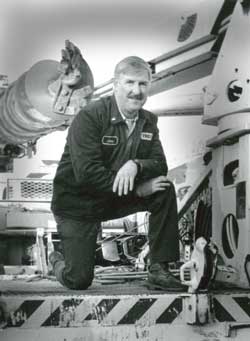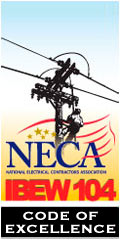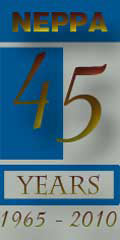NEPPA eNewsletter
August 2010
Installing wind turbines on an island off the Maine coast has its own special problems, according to Charles (Chip) Farrington, general manager of the Fox Islands Electric Cooperative, Inc.
The Coop serves two small islands accessible by a 1 hour and 20 minute ferry ride from Rockland, Maine and during the winter serves less than 2,000 customers. The islands' populations more than triple during the summer months. Before wind power came to the island, the population depended on underwater cables from the mainland to bring electricity. This often caused reliability problems and resulted in very high electric rates.
The wind project began in 2001 when the cooperative applied for and received a grant for a three-year wind-resource study conducted by the University of Massachusetts Renewable Energy Research Laboratory. When the results indicated that wind power was a viable option for the utility, Farrington began working with General Electric specifications to do a financial analysis which then led to a feasibility study.
Click here to get details of the projects financing and planning.
Dr. George Baker, a seasonal resident of Frenchboro Island and a Harvard Business School professor, was engaged to do a preliminary economic analysis and create a financial plan. The Coop then entered the feasibility stage, which included an engineering study and an economic strategy. In July 2008 the ratepayers on both Vinalhaven and North Haven voted overwhelmingly 382 to 5 in favor of the project.
Getting the large turbines and blades over to the island on barges was no easy task and getting them from the shore to the site via narrow, winding roads proved very difficult - however, not impossible, as construction commenced on June 8, 2009. At the same time it was discovered that upgrades to the islands' main substation were needed and a race to the finish line ensued. The substation was ready to go two days before the completion of the three towers and a grid tie-in took place in October. General Electric begin the commissioning process for the turbines in November and Fox Islands Wind generated its first kilowatts during its testing. GE trained utility Lineworkers Loren Bunker and Joe Bickford in the operation and maintenance of the units.
Sixty percent of the wind power stays on the island and 40 percent is sent via cable to ISO New England. The electric rates on the island have been reduced by 15 to 20 percent and residents are highly supportive of the Fox Island Wind.
"The hardest part was getting started," said Farrington. "The feasibility of the project had many aspects that needed to be explored but it was all challenging and worthwhile."

##SHARELINKS##
| |
EXECUTIVE DIRECTOR'S REPORT
For a long time, NEPPA’s training and educational programs have been focused primarily on the technical and operations side of public power utilities: linework; substations; meters and electrical safety. This focus reflected what was, for many of our members, the most critical need of small public power systems throughout New England: assuring that their distribution systems were constructed, maintained and operated in a professional, safe and reliable manner by their own employees. For many small systems, having their employees trained and competent in these skills was the only reason to make investments in their staff’s professional development.
While these skills continue to be critical for any electric utility, it is well recognized that the "business" side of public utilities is no less important to a well-run and financially sound organization. Furthermore, the introduction of new digital technologies affecting all aspects of business management has added enormous pressures on professionals in these positions to learn, adapt and implement new systems and procedures on a regular basis. Recognizing this need for constant learning and adaption in these areas of utility operations, NEPPA is trying to assist its members in a variety of ways.
In the next few months, three programs have been scheduled specifically for utility business and finance professionals: a one-day "Business Forum" on Sept. 24, a "Billing System Roundtable" on Sept. 30, and a workshop on the "Fundamentals of Utility Accouting" on Oct. 7. Each of these programs have been designed to help NEPPA members remain current with developments in their fields, and to learn from their public power colleagues about how they deal with similar problems and challenges.
The Business Forum will cover such topics as electronic billing and payment systems, data security, freedom of information requirements, and utility customer bankruptcies, with experts making presentations on each topic.
The Billing System Roundtable is an opportunity for public power officials to share information, knowledge and experience about their billing systems, and to learn more about the features of different systems being utilized in our region.
Finally, the accounting workshop will provide a one-day overview of utility accounting fundamentals for new accountants or others who need to have a better understanding of this subject.
These programs reflect NEPPA’s commitment to provide an ever-expanding number and range of educational opportunities for our members, in all areas of utility management and operations. While we are proud of our longstanding safety, technical and lineworker training classes, as well as more recent programs in customer service and crew leadership, we are pleased to offer these new programs to those responsible for the "business side" of public power. We hope you will take advantage of these programs, and tell us what else we can do to be of assistance.
##SHARELINKS##
|
AROUND NEW ENGLAND
John McRae, former general line foreman of the Taunton Municipal Light Plant, died at his home on July 27 following a period of failing health. Born in Brockton, Mass., he was educated in Taunton Schools, graduating from high school in 1964. He started his 34-year career with TMLP as an apprentice lineworker working with his father, who had a long career at TMLP as a lineworker and troubleman. Mr. McRae is a 4th generation lineworker and his son, John, is following in his footsteps.
In the late '60s, McRae joined with several other lineworkers from municipals across the state to establish the Massachusetts Municipal Lineman's Association. This group was instrumental in getting electric lineworkers with the association hazardous occupation retirement benefits in 1973. Over the years, he held several positions including president.

While serving in the U.S. Army, he spent many months in 1966-1967 in the central highlands of Vietnam and he wrote the standard for Power Line Training for the U.S. Military. He retired as a SFC in the U.S. Army Reserves, and some of his medals include National Defense Service Medal, Army Reserve Components Achievement Medal (2nd Oak Leaf Cluster) Army Service Ribbon, and Viet Nam Service Medal. Vietnam Campaign Medal, Republic of Vietnam Gallantry Cross, Meritorious Unit Commendation and the Army Commendation Medal.
He was active in the Army military reserves for over 20 years and was a key component in both of NEPPA's mutual aid relief efforts to St. Croix and St. Thomas in the mid-nineties. His contacts in the military helped arrange for C5 aircraft to airlift line crews from Massachusetts to the Virgin Islands. Mr. McRae competed in both the American Public Power Association and NEPPA lineworker rodeos.
After retiring from TMLP in 2002, he began a new career in San Diego, Calif. as the apprentice training director of San Diego Gas and Electric. He became an instructor at SDG&E’s Skills Training Center in Mission Valley, where he had the opportunity to pass along his experiences to many SDG&E apprentice linemen, including his son, John Jr., who today, is a journeyman lineman at Beach Cities.
"We are forever grateful to John for his leadership, influence, knowledge, experience, and outreach," said Keoki Kamau, operations performance support manager at the Skills Training Center in Mission Valley. "John’s charismatic personality and ability to include everyone made him a lifelong friend to so many people and one super, special person."
He was a member and past president of local 1729 SFCME and also of Local 465 IBEW in San Diego. He spoke to utility lineworkers throughout the country on Electrical Training.
He leaves his wife Marianne (Dolan) McRae, four children and three grandchildren. Donations in his memory may be made to the DAV or Home for our Troops, Taunton Green, Taunton, MA 02780.
##SHARELINKS##
|
ASSOCIATION HAPPENINGS
 2010 Annual Conference 2010 Annual Conference
The Renaissance Providence Hotel
Providence, Rhode Island
August 15 - 18
There's still time to register. Click here for details.
##SHARELINKS##
|
|
Noble Americas Gas & Power of Four Stamford Plaza, 107 Elm St., Stamford, Conn., has joined NEPPA as a corporate member. Dana Volpe, Vice President may be reached at (203) 326-3570. Noble Americas is a wholesale electricity supply and purchase firm, as well as a trading and marketing company.
Macquarie Energy has joined NEPPA as an associate member. Roberta Konicki is our main contact and she can be reached at (713) 275-6278. Macquarie Energy is a wholesale trading and marketer focusing in the Northeast markets.
##SHARELINKS##
|
THE LEARNING CORNER
Thinking is simple, right? We do it automatically, constantly and naturally. We do it - pardon the expression - without thinking. Everyone knows that we use our brain to think, but how many of us know that different parts of our brain control different ways of thinking?
That discovery was made in the late 1970s when Ned Herrmann, head of management education at General Electric at the time, conducted research that culminated in two articles he published in Training & Development magazine in 1981 and 1982 titled "The Creative Brain, Parts I and II."
Herrmann’s thesis was revolutionary. The brain, he wrote, is divided into two parts, or "hemispheres," that control different modes of mental activity. The left brain produces thinking that is logical, analytical, sequential, planned and detailed. It is objective thinking, and it notices parts of things, rather than things as a whole.
The right brain, on the other hand, sees things not in sequential order, but randomly and subjectively. The thinking is emotional and interpersonal, and it seeks to synthesize our experiences rather than keep them separate from each other. The right brain focuses on wholes, not parts. According to Herrmann, each of us, without even knowing it, usually prefers one mode over the other, and we tend to use that part of the brain more than the other.
The significance of this discovery is profound. It helps explain why some people are very logical and analytical, while others are more emotional, with their feelings closer to the surface. Whereas some people notice details and remember concrete facts, others are more in tune with "the big picture" or the feelings that a situation prompts in them.
As a manager, have you ever witnessed one of your employees approaching a task one idea at a time, step-by-step, while another employee attacks it by thinking of many ideas at once in a seemingly random manner? One person who analyzes the facts in a situation, while someone else focuses on the emotions of the persons going through the situation? You are witnessing left-brained and right-brained persons in operation.
Our educational system and our workplaces have always placed a higher value on being logical, practical and objective. With multiple choice exams on facts and numbers, schools emphasize "figuring out" the one right answer to a question. In the workplace, we are encouraged to solve problems by systematically identifying the causes of the problem, listing all the possible options, and analyzing their pro’s and con’s to select the most appropriate solution. That’s the left hemisphere at work.
There’s nothing wrong with left-brain thinking, but it can limit us if that’s the only kind of thinking we do. Sometimes what’s needed is a more imaginative or innovative idea, a flash of insight. It helps to rely on our intuition about a situation, especially if we have years of experience with similar situations. Those years of experience give us quick insights, or instincts, and those insights lead to imaginative and creative solutions. That’s the right hemisphere.
The key, then, is balance. Although each of us may find one mode of thinking easier, we need to use both as we work, as we learn, and as we manage others. By exercising that "other hemisphere," we develop our whole brain and find more comprehensive ways of thinking about, and solving, problems. As Daniel Pink, author of The Whole New Mind, says, "What people need today isn’t one side of the brain or the other, but...a whole new mind."
##SHARELINKS##
|




|
|






